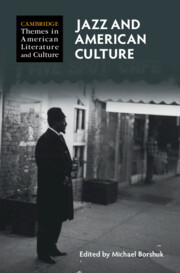Book contents
- Jazz and American Culture
- Cambridge Themes in American Literature and Culture
- Jazz and American Culture
- Copyright page
- Contents
- Contributors
- Acknowledgments
- Introduction
- Part I Elements of Sound and Style
- Part II Aesthetic Movements
- 5 Jazz Age Harlem
- 6 “Hard Times Don’t Worry Me”
- 7 A Fool for Beauty
- 8 Free Jazz, Critical Performativity, and 1968
- Part III Cultural Contexts
- Part IV Literary Genres
- Part V Images and Screens
- Bibliography
- Index
7 - A Fool for Beauty
Modernism and the Racial Semiotics of Crooning
from Part II - Aesthetic Movements
Published online by Cambridge University Press: 09 November 2023
- Jazz and American Culture
- Cambridge Themes in American Literature and Culture
- Jazz and American Culture
- Copyright page
- Contents
- Contributors
- Acknowledgments
- Introduction
- Part I Elements of Sound and Style
- Part II Aesthetic Movements
- 5 Jazz Age Harlem
- 6 “Hard Times Don’t Worry Me”
- 7 A Fool for Beauty
- 8 Free Jazz, Critical Performativity, and 1968
- Part III Cultural Contexts
- Part IV Literary Genres
- Part V Images and Screens
- Bibliography
- Index
Summary
Crooning emerged as a style that contemporaneous audiences, black and white, read as “white”: it wasn’t until the early 1930s that African American crooners appeared on record. This delay is unusual in American music, where innovations in vernacular music ordinarily have African American origins. That delay is explicable, however, once we recover what crooning signified for black audiences and how that signified meant something different to white audiences. More interesting still is the fact that crooning continues to play a role in contemporary African American music, long after white audiences abandoned it as old-fashioned. The apotheosis of this pattern can be heard in the 1963 record, John Coltrane and Johnny Hartman. Trane then made his one record with a vocalist for fairly obvious reasons, but it is less clear why he chose to do so, not with a jazz singer, but a crooner.
- Type
- Chapter
- Information
- Jazz and American Culture , pp. 110 - 126Publisher: Cambridge University PressPrint publication year: 2023

